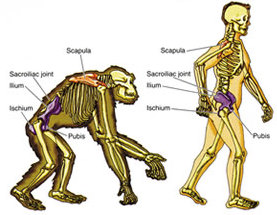 The position of your knees in backbending, as in all of yoga, is one key to maintaining a happy healthy body. One of my constant refrains is, “What you can get away with in your twenties thirties and forties might come back to haunt you in your seventies and eighties.” And the alignment of the knees has so much to do with how we proceed into old age.
The position of your knees in backbending, as in all of yoga, is one key to maintaining a happy healthy body. One of my constant refrains is, “What you can get away with in your twenties thirties and forties might come back to haunt you in your seventies and eighties.” And the alignment of the knees has so much to do with how we proceed into old age.
When walking or standing, the middle of the kneecap is meant to be lined up directly over the center of the ankle joint. This is equally important when practicing asana. While it seems obvious that yoga is good for you, it is also very easy to injure yourself if you are not paying attention to the details of alignment.
When humans came up to stand on two legs we developed strength in certain muscles that stabilized the pelvis bring the knees under the hips, allowing us to walk in an upright fashion. Gorillas and apes don’t have the same strength in their pelvis and as a result can’t walk the same way we do. Our simian ancestors had differently shaped legs. Our thigh bones come out of the hip sockets and angle in towards the midline of the body. Their thigh bones go straight down to the foot. The lack of stability in the simian pelvis means that each step they take, the entire weight of the body moves sideways over the moving leg.
There are many reasons why many human knees tend to follow a similar pattern. Weak gluteal muscles and tight IT bands are very often the reason (I’ll write about them more as I move up the body in backbends. The pelvis is next). One of the images I refer to is a guy in jeans with no butt. While the butt should fill out the back of one’s jeans very often the fabric goes straight down from the waist to the leg and their remains a big empty pocket where the butt should be. This imaginary person is going to walk sort of like an ape.
Referring to yesterday’s post, when you go up into wheel pose your feet should remain grounded through all four corners. If that is the case there is no real need for the knee to stray off the midline. But the minute the feet either turn open or fall to the outside the knee goes with it. As soon as the knee moves away from the line of the ankle joint, the femur bone of the thigh also moves out to the side which will begin compromise the Sacroiliac joints of the pelvis.
Your psoas, my favorite muscle, connects the legs to the spine and requires a slight internal rotation in order to engage and affect the expansion of the Sacroiliac joint and the lengthening of the spine and back body. If your knees move wide of the midline you lose the ability to get the inner upper thigh to do its bit of internal rotation that is essential to any backbend.
From my perspective, that is the start of most back pain in the yoga practice. It is not the only way to hurt yourself but it is a big one. I plan on doing backbends into my eighties so I pay close attention now to how my feet and knees align when I go into wheel.
